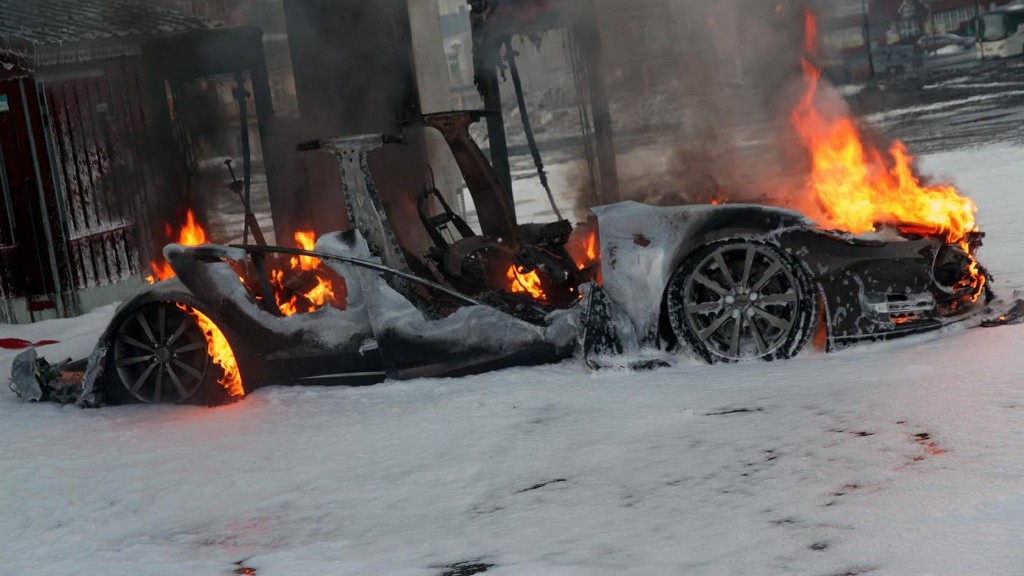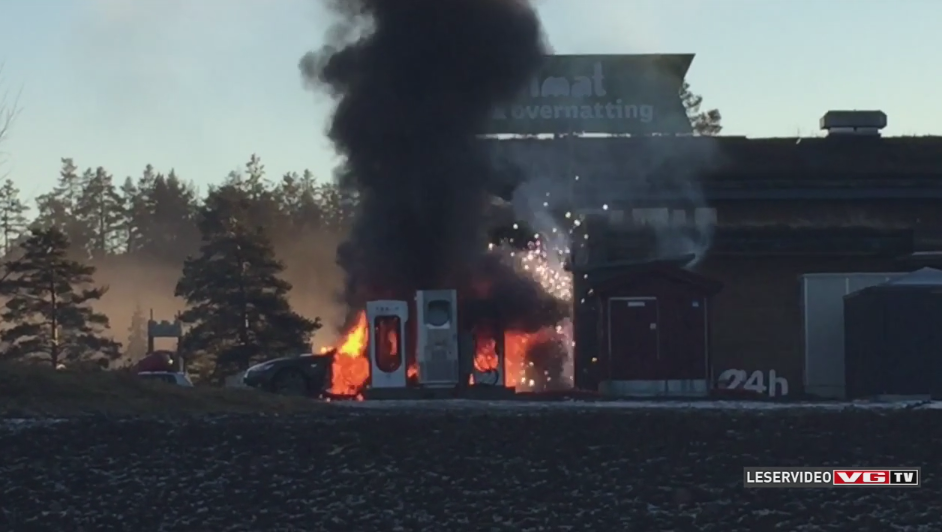Tesla Motors has had a spot of bad news – another Model S has caught on fire, this time not from road debris but while plugged into a Supercharger station. This happened in Norway, according to a news post on fvn.co![]() , for a brand new car. The owner had plugged in, and just walked away from the car when it caught fire. Because the fire department doesn’t have the right equipment to fight a lithium battery fire — they’d need water laced with copper — the firefighters just let the fire burn itself out. (the picture above comes from the FVN article)
, for a brand new car. The owner had plugged in, and just walked away from the car when it caught fire. Because the fire department doesn’t have the right equipment to fight a lithium battery fire — they’d need water laced with copper — the firefighters just let the fire burn itself out. (the picture above comes from the FVN article)
According to online discussions summarized below, this looks like a failure in the on-board charging equipment. The fire pattern doesn’t match other Tesla Model S fires. Instead it appears the fire began in the charging equipment, then involved the rest of the car, and it’s possible the battery pack did not catch fire.
The fire broke out at 2:30 PM local time in Brokelandsheia in Gjerstad Norway. The car’s owner and it’s passenger had just walked away — the location is next to a roadside burger joint going by pictures on the FVN website — when the car caught on fire. Steinar Olsen of the East Agder fire department is quoted saying “The car was completely ablaze when firefighters arrived. The only thing we could do was to cordon off the area and cool with foam” (original: Bilen var helt overtent da brannmannskapene kom fram. Det eneste vi kunne gjøre var å sperre av området og kjøle med skum)
That leads to an article on NRK.no![]() with little additional information.
with little additional information.
According to comments on the TeslaMotorsClub forum![]() , the Supercharger shown in the picture is a “temporary” unit. Going by pictures on the FVN article, there are permanent Supercharger’s at the same location, but this car was at a temporary unit. The discussion thread on Reddit
, the Supercharger shown in the picture is a “temporary” unit. Going by pictures on the FVN article, there are permanent Supercharger’s at the same location, but this car was at a temporary unit. The discussion thread on Reddit![]() contains a comment: “It was parked at a temporary charger, not the permanent ones. Source: I was there a few days ago and know the place.” Another commentor who’s used that site says it was one of the first six Supercharger sites in Europe/Norway. The permanent stations at the site are limited to 108 kiloWatts, and the temporary unit shown here can run at up to 118 kiloWatts.
contains a comment: “It was parked at a temporary charger, not the permanent ones. Source: I was there a few days ago and know the place.” Another commentor who’s used that site says it was one of the first six Supercharger sites in Europe/Norway. The permanent stations at the site are limited to 108 kiloWatts, and the temporary unit shown here can run at up to 118 kiloWatts.
A short video by VGTV shows that the pack was involved in the fire. At the very beginning there’s a “pop” and a burst of sparks. This effect occurs as individual cells in the pack ignite.
The difficulty with confirming the pack caught fire is a design detail we learned from previous Model S fires. Namely, the Model S battery pack is designed to funnel battery pack fire out the front of the car rather than keep it in the vicinity of the passenger compartment. But we clearly see in this case the fire destroyed the passenger compartment, and in this video no fire is emanating out the front of the car.
It’s possible the pop-and-sparks were not due to the battery pack, but something else. This video shows a burning gasoline car![]() and a similar pop-and-sparks when the airbags burst. We have to consider whether this fire was in some other system than the power electronics (battery pack etc). The pop-and-sparks occurs in the rear of the Model S, FWIW, where the charging equipment is located.
and a similar pop-and-sparks when the airbags burst. We have to consider whether this fire was in some other system than the power electronics (battery pack etc). The pop-and-sparks occurs in the rear of the Model S, FWIW, where the charging equipment is located.
The charging cables appear to be intact (though charred) which rules out an electrical fire in the charging station equipment.
Going by where the heaviest damage occurred![]() : “Firefighter here. Investigators will be looking for the heaviest concentration of damage as the source of the fire (where it burned longest/hottest = point of origin). It’s difficult to tell with one two-dimensional photo, but to me it looks like the heaviest damage is immediately over the rear wheels. A second possibility is the forward lower part of the cabin, where the dash would have been, but with the lesser damage forward of that (including the front bumper being almost undamaged in places), I’m leaning towards the rear of the vehicle.” A followup comment notes that area, near the rear wheels, is where the charging contactor and other charging equipment is located.
: “Firefighter here. Investigators will be looking for the heaviest concentration of damage as the source of the fire (where it burned longest/hottest = point of origin). It’s difficult to tell with one two-dimensional photo, but to me it looks like the heaviest damage is immediately over the rear wheels. A second possibility is the forward lower part of the cabin, where the dash would have been, but with the lesser damage forward of that (including the front bumper being almost undamaged in places), I’m leaning towards the rear of the vehicle.” A followup comment notes that area, near the rear wheels, is where the charging contactor and other charging equipment is located.
A post on tv2.no![]() shows pictures consistent with a charging system fire. A post on hegnar.no
shows pictures consistent with a charging system fire. A post on hegnar.no![]() confirms comments on discussion boards that the owner had bought this Model S two days earlier. However, the discussions elsewhere suggest it was a used 2014 Model S, not a brand new vehicle. In any case, the Hegnar.no post says the owner had lent this car to a friend, and it was in the friend’s custody when the car caught fire.
confirms comments on discussion boards that the owner had bought this Model S two days earlier. However, the discussions elsewhere suggest it was a used 2014 Model S, not a brand new vehicle. In any case, the Hegnar.no post says the owner had lent this car to a friend, and it was in the friend’s custody when the car caught fire.
So far this is all Internet Forensics, and it’s difficult from looking at pictures what really happened. However, there’s enough evidence suggesting it’s likely the fire was due to a charging system problem. That something in the on-board charging equipment failed and caught fire.
A contributing factor is the design of the Supercharger plug used in Europe. As shown here, it uses the Mennekes Type 2 plug that other automakers use for level 2 charging support. This plug is not spec’d to handle the power level used by the Supercharger.
According to the Wikipedia page on the Type 2 connector![]() , the Mennekes Type 2 plug is designed to support single phase AC, three phase AC, and DC charging at power levels up to 70 kiloWatts. The physical size of power pins is the limiting factor for power through any kind of electrical connection. As we noted earlier, this car was connected to a Supercharger station supporting 118 kiloWatts of power.
, the Mennekes Type 2 plug is designed to support single phase AC, three phase AC, and DC charging at power levels up to 70 kiloWatts. The physical size of power pins is the limiting factor for power through any kind of electrical connection. As we noted earlier, this car was connected to a Supercharger station supporting 118 kiloWatts of power.
When the European’s adopted the Combo Charging System they added two DC power pins – just as they’d done when the North American Combo Type 1 plug which was a normal J1772 plug with two DC power pins.
Could it be that (gasp) Tesla Motors made a mistake? That the European Supercharger is not entirely fire safe?
Before someone jumps on me for that statement — I’ve written up several electric car fires in the past, and consistently pointed out that we see hundreds of thousands of gas car fires per year in the US (in the millions world-wide) without major news coverage. Electric car fires so far are much rarer than gas car fires.
Another post on NRK![]() quotes representatives from the Norwegian EV Association repeating this factoid, and suggesting that Tesla’s charging equipment is safe.
quotes representatives from the Norwegian EV Association repeating this factoid, and suggesting that Tesla’s charging equipment is safe.
Tesla Motors gave this statement: No one was injured. We do extensive research and then come back with more answers.
Basically, it’s too early to diagnose the real problem, especially based on Internet Forensics.
- Is there enough Grid Capacity for Hydrogen Fuel Cell or Battery Electric cars? - April 23, 2023
- Is Tesla finagling to grab federal NEVI dollars for Supercharger network? - November 15, 2022
- Tesla announces the North American Charging Standard charging connector - November 11, 2022
- Lightning Motorcycles adopts Silicon battery, 5 minute charge time gives 135 miles range - November 9, 2022
- Tesla Autopilot under US Dept of Transportation scrutiny - June 13, 2022
- Spectacular CNG bus fire misrepresented as EV bus fire - April 21, 2022
- Moldova, Ukraine, Georgia, Russia, and the European Energy Crisis - December 21, 2021
- Li-Bridge leading the USA across lithium battery chasm - October 29, 2021
- USA increasing domestic lithium battery research and manufacturing - October 28, 2021
- Electrify America building USA/Canada-wide EV charging network - October 27, 2021


























Pingback: BBQ in Norway - Tesla S - Smart Car Forums